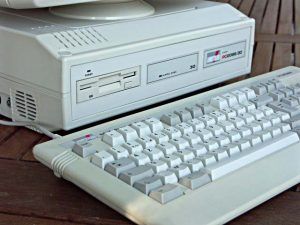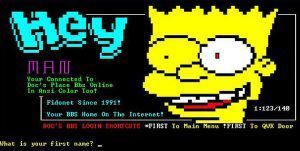More than 4 decades ago, I was a teenager and had the good fortune to win a computer in a contest. A computer with 640 KB of RAM, a mouse, a 30 MB hard drive, low-density 3.5” floppy disks, a grayscale monitor, MS-DOS and Windows 1… which I had on my desk for over a year without knowing what to do with it. Neither I nor any of my friends at the time. Some of them had computers like the Amstrad CPC464, Sinclair ZX Spectrum, Amstrad PCW 8256, etc. And basically what they did with them was rent cassette-format games from a video store, copy them, and play.

I had won a crappy computer!… or so I thought. Over time I learned to turn it on and manage MS-DOS relatively well and do a few things with the spartan Windows that fascinated all my friends but was useless to me for gaming or anything else. Until a math teacher, Andrés, told me he had taken a C programming course – programming? What was that? – and lent me the course material and the compiler. It took me about 6 months to make my first “hello world.” And from there I began to discover the fascinating world of computing.
Without books, without anyone to share information with, and without the Internet (which now seems like it has always been there, but obviously wasn’t), I progressed very slowly. That’s when another math teacher, Abilio, allowed me to use a computer in a room at the school that had a modem and connection to the Basic Telephone Network (RTB) to experiment. I had read in a magazine how to access Ibertext and the Bulletin Board System (BBS). It was hard, but from there I obtained huge amounts of information (very well organized and good at the time; no fluff): news about programming and hacking from Fidonet, assembler courses, BASIC courses… Until they cut me off! At 21 pesetas per minute of connection, after a while my school told me they couldn’t continue giving me access.

I think they never suspected how much that opportunity changed my life. There were three key moments: winning “a crappy computer that didn’t let me play,” discovering the world of C programming, and gaining access to the world at 21 pesetas per minute.
The information I obtained during the months I had connection was incredibly useful. And even though it was in English and the 90s were just beginning (my proto-English couldn’t be more rudimentary), by around 1991 I was programming relatively well in C, BASIC, and 8086 assembler. I made my own games and programs for my “crappy computer” (which I was beginning to understand wasn’t so crappy), and I definitely decided I wanted to study Computer Engineering after finishing high school. And so it was.
Many times we tend to believe that investment in equipment in educational centers doesn’t make much sense. And surely in many cases it’s true; it’s a quick and easy way to “burn public money” and for the politician of the moment to get a few photos. It’s seen as wasteful. The same goes for staffing and teacher training. But one thing is very clear to me: I wouldn’t be a Computer Engineer today if not for the convergence of two particular facts:
- I was lucky to have qualified and dedicated teachers during my primary and secondary education. And by “dedicated” I mean “beyond what is required by their professional role.”
- I had the luck to study in a center where there was equipment that, for the time, was surely considered wasteful or excessive, and where there was a willingness to put it “at the service” of the students.
So, when thoughts like “what a waste,” “what a way to squander money” come to mind, even knowing that in many cases it’s true, I like to imagine that somewhere there’s a boy or girl investigating how a certain “gadget” works, helped by a committed teacher, and maybe, without knowing it, their life is being changed.